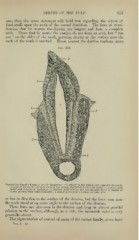Page 647 - My FlipBook
P. 647
^'ERVES OF THE PULP. 657
case, then the same statement will hold true regarding the action of
food-stuffs upon the teeth of the second dentition. The lines of strati-
fication that lie nearest the dentine are longest and form a complete
arch. Those that lie nearer the surface do not form an arch, but " run
out " on the sides of the tooth, growing shorter as the surface near the
neck of the tooth is reached. Those nearest the dentine conform more
Fig. 369.
Vertical Section of a Tooth in situ Clo diameters) : c is placed in the pulp-cavitv, opposite the cervix
or neck of the tooth ; the part above is the crown, tliat below is tlio root (fang). 1, enamel with
radial and concentric markings; ;'
2, dentine with tubules and incremental lines 8, cement or
crusta petrosa, with bone-corpuscles ; 4, dental periosteum ; 5, bone of lower jaw.
or less in direction to the surface of the dentine, but the lines seen near
the neck stand at an acute angle to the surface of the dentine.
These lines are also seen in the dentine and bear an almost parallel
relation to the surface, although, as a rule, the brownish color is very
generally absent.
The pigmentation of enamel of many of the rodent family, as we have
Vol. I.—42


